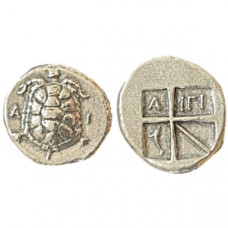Reproduction Islands off Attica Aegina Stater
Obverse: A-I to left and right of land tortoise with segmented shell.
Reverse: Incuse square divided by skew-pattern into five compartments. In the upper two, the inscription Α-ΙΓΙ abbreviation for "AEGINA" ("ΑΙΓINA"). In the lower left, dolphin swimming upwards.
History: The island of Aegina was the first state in Ancient Greece to mint coins, beginning in c.550 BC. Silver coins were struck at the mint and these coins became locally known as the Aeginetic drachm (stater). The coins from Aegina were uniform of type and were not just a local currency, but circulated widely as trade coins throughout Ancient Greece.
The early Aeginetic coins depicted a sea turtle with a plain shell, on the obverse. The reverse of these early coins showed an incuse square divided into hollowed-out triangles. Around 404 BC the sea turtle was replaced by a land tortoise, sometimes accompanied with an "A" to the left and "I" to the right on the larger denominations. The reverse of these new coins featured a square divided into four parts, with one, being divided into two triangles. Across the top two squares, it would read "ΑΙΓΙ", an abbreviation for "AEGINA" ("ΑΙΓINA"), while one of the bottom squares depicted a dolphin.
This coin dates from c.350-338 BC and is one of the later coins depicting the land tortoise on the obverse and the revised reverse with inscription and dolphin.
Minted: Aegina mint, circa 350-338 BC.
Diameter: 2.1cm
Tags: Islands off Attica, Aegina, Silver, Stater, Drachm, Land Tortoise, Dolphin, Greek, Reproduction, Replica, Coin




